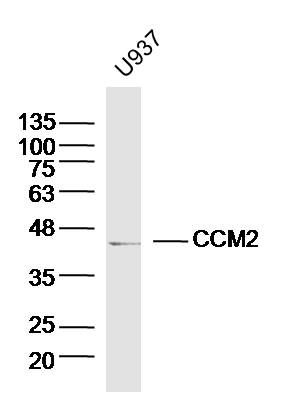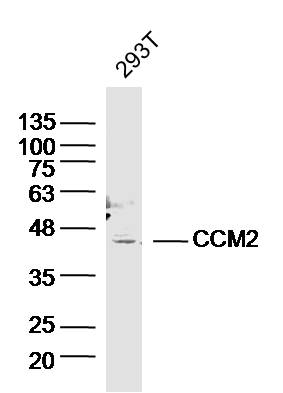
Rabbit Anti-CCM2 antibody
Malcavernin; C7orf22; Ccm2; CCM2_HUMAN; Cerebral cavernous malformation 2; Cerebral cavernous malformations 2 protein; Malcavernin; MGC4067; MGC4607; MGC74868; PP10187.
View History [Clear]
Details
Product Name CCM2 Chinese Name 脑海绵状血管畸形蛋白2抗体 Alias Malcavernin; C7orf22; Ccm2; CCM2_HUMAN; Cerebral cavernous malformation 2; Cerebral cavernous malformations 2 protein; Malcavernin; MGC4067; MGC4607; MGC74868; PP10187. Research Area Cell biology Neurobiology Immunogen Species Rabbit Clonality Polyclonal React Species Human, (predicted: Mouse, Rat, Cow, Horse, Sheep, ) Applications WB=1:500-2000 ELISA=1:5000-10000 IHC-P=1:100-500 IHC-F=1:100-500 ICC=1:100-500 IF=1:100-500 (Paraffin sections need antigen repair)
not yet tested in other applications.
optimal dilutions/concentrations should be determined by the end user.Theoretical molecular weight 49kDa Cellular localization cytoplasmic Form Liquid Concentration 1mg/ml immunogen KLH conjugated synthetic peptide derived from human Malcavernin: 18-100/444 Lsotype IgG Purification affinity purified by Protein A Buffer Solution 0.01M TBS(pH7.4) with 1% BSA, 0.03% Proclin300 and 50% Glycerol. Storage Shipped at 4℃. Store at -20 °C for one year. Avoid repeated freeze/thaw cycles. Attention This product as supplied is intended for research use only, not for use in human, therapeutic or diagnostic applications. PubMed PubMed Product Detail Cerebral cavernous malformation (CCM) is an autosomal dominant or sporadic neurovascular disease marked by vascular anomalies located mostly in the central nervous system that can cause stroke, seizures, cerebral hemorrhages, headaches and focal neurologic deficits. CCM is caused by mutations in one of three genes: CCM1, CCM2 or CCM3. CCM1 encodes the protein KRIT1, CCM2 encodes the protein Malcavernin and CCM3 shares its name with the protein it encodes. Malcavernin, also designated cerebral cavernous malformations 2 protein, is a scffolding protein for MEK kinase-3. Like KRIT1, Malcavernin is expresed in a variety of human organs including the arterial vascular endothelium, pyramidal neurons, astrocytes and their foot processes. In addition, Malcavernin is expressed in various epithelial cells that are required for the formation of the blood-organ barrier. Malcavernin is localized to the cytoplasm but is known to shuttle to and from the nucleus. Due to its lack of a nuclear export signal or nuclear localization signal, it is believed that Malcavernin accomplishes this shuttling via an attachment to KRIT1, which contains a nuclear localization signal. Two isoforms exist for Malcavernin. Isoform 1 represents the full length protein while isoform 2 contains an alternative four amino acid sequence rather than the first 10 residues of isoform 1.
Function:
May function as a scaffold protein for MAP2K3-MAP3K3 signaling. Seems to play a major role in the modulation of MAP3K3-dependent p38 activation induced by hyperosmotic shock.
Subunit:
Part of a complex with MAP2K3, MAP3K3 and RAC1. Binds RAC1 directly and independently of its nucleotide-bound state (By similarity). Interacts with PDCD10. Interacts with HEG1 and KRIT1; KRIT1 greatly facilitates the interaction with HEG1 (By similarity).
Subcellular Location:
Cytoplasm.
DISEASE:
Defects in CCM2 are the cause of cerebral cavernous malformations type 2 (CCM2) [MIM:603284]. Cerebral cavernous malformations (CCMs) are congenital vascular anomalies of the central nervous system that can result in hemorrhagic stroke, seizures, recurrent headaches, and focal neurologic deficits. CCMs have an incidence of 0.1%-0.5% in the general population and are usually present clinically during the 3rd to 5th decades of life. The lesions are characterized by grossly enlarged blood vessels consisting of a single layer of endothelium and without any intervening neural tissue, ranging in diameter from a few millimeters to several centimeters.
Similarity:
Contains 1 PID domain.
SWISS:
Q9BSQ5
Gene ID:
83605
Database links:Entrez Gene: 83605 Human
Omim: 607929 Human
SwissProt: Q9BSQ5 Human
Unigene: 148272 Human
Product Picture
Primary: Anti- CCM2 (SL11817R)at 1/300 dilution
Secondary: IRDye800CW Goat Anti-Rabbit IgG at 1/20000 dilution
Predicted band size: 49 kD
Observed band size: 45 kD
Bought notes(bought amounts latest0)
No one bought this product
User Comment(Total0User Comment Num)
- No comment




 +86 571 56623320
+86 571 56623320
 +86 18668110335
+86 18668110335

